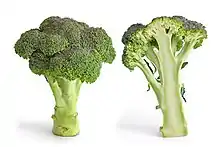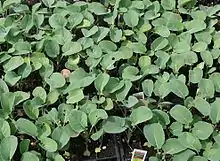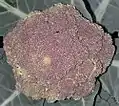Broccoli
Broccoli (Brassica oleracea var. italica) is an edible green plant in the cabbage family (family Brassicaceae, genus Brassica) whose large flowering head, stalk and small associated leaves are eaten as a vegetable. Broccoli is classified in the Italica cultivar group of the species Brassica oleracea. Broccoli has large flower heads, usually dark green, arranged in a tree-like structure branching out from a thick stalk which is usually light green. The mass of flower heads is surrounded by leaves. Broccoli resembles cauliflower, which is a different but closely related cultivar group of the same Brassica species.
| Broccoli | |
|---|---|
 | |
| Species | Brassica oleracea |
| Cultivar group | italica |
| Origin | Italy, more than 2,000 years ago[1][2] |
It is eaten either raw or cooked. Broccoli is a particularly rich source of vitamin C and vitamin K. Contents of its characteristic sulfur-containing glucosinolate compounds, isothiocyanates and sulforaphane, are diminished by boiling but are better preserved by steaming, microwaving or stir-frying.[3]
Rapini, sometimes called "broccoli rabe," is a distinct species from broccoli, forming similar but smaller heads, and is actually a type of turnip (Brassica rapa).[4]

Etymology
The word broccoli comes from the Italian plural of broccolo, which means "the flowering crest of a cabbage", and is the diminutive form of brocco, meaning "small nail" or "sprout".[5] The Broccoli family, whose members include Albert R. Broccoli and Barbara Broccoli and are known in the 20th and 21st century for producing the James Bond films, also claim that the vegetable is named after their ancestors, the Broccolis of Carrara.[6][7]
History
Broccoli resulted from breeding of landrace Brassica crops in the northern Mediterranean starting in about the sixth century BCE.[8] Broccoli has its origins in primitive cultivars grown in the Roman Empire and was most likely improved via artificial selection in the southern Italian Peninsula or in Sicily.[9][10][11] Broccoli was spread to northern Europe by the 18th century and brought to North America in the 19th century by Italian immigrants.[10] After the Second World War, breeding of United States and Japanese F1 hybrids increased yields, quality, growth speed, and regional adaptation, which produced the cultivars that have been the most popular since then: 'Premium Crop', 'Packman', and 'Marathon'.[10]
Other cultivar groups of Brassica oleracea
Other cultivar groups of Brassica oleracea include cabbage (Capitata Group), cauliflower and Romanesco broccoli (Botrytis Group), kale (Acephala Group), collard (Viridis Group), kohlrabi (Gongylodes Group), Brussels sprouts (Gemmifera Group), and kai-lan (Alboglabra Group).[12] As these groups are the same species, they readily hybridize: for example, broccolini or "Tenderstem broccoli" is a cross between broccoli and kai-lan.[13] Broccoli cultivars form the genetic basis of the "tropical cauliflowers" commonly grown in South and Southeastern Asia, although they produce a more cauliflower-like head in warmer conditions.[14][10]
| Broccoli production — 2019 (includes cauliflower) | |
|---|---|
| Country | Production millions of tonnes |
| 10.6 | |
| 9.1 | |
| 1.2 | |
| 0.7 | |
| 0.7 | |
| World | 26.9 |
| Source: FAOSTAT of the United Nations[15] | |
Varieties
There are three commonly grown types of broccoli.[10] The most familiar is Calabrese broccoli, often referred to simply as "broccoli", named after Calabria in Italy. It has large (10- to 20-cm) green heads and thick stalks. It is a cool-season annual crop. Sprouting broccoli (white or purple) has a larger number of heads with many thin stalks.[16] Purple cauliflower or violet cauliflower is a type of broccoli grown in Europe and North America. It has a head shaped like cauliflower but consisting of many tiny flower buds. It sometimes, but not always, has a purple cast to the tips of the flower buds. Purple cauliflower may also be white, red, green, or other colors.[17]
Other popular cultivars include Belstar, Blue Wind, Coronado Crown, Destiny, DiCicco, Green Goliath, Green Magic, Purple Sprouting, Romanesco, Sun King and Waltham 29.[18][11]
Beneforté is a variety of broccoli containing 2–3 times more glucoraphanin and produced by crossing broccoli with a wild Brassica variety, Brassica oleracea var villosa.[19]
Cultivation
The majority of broccoli cultivars are cool-weather crops that do poorly in hot summer weather. Broccoli grows best when exposed to an average daily temperature between 18 and 23 °C (64 and 73 °F).[20][21] When the cluster of flowers, also referred to as a "head" of broccoli, appear in the center of the plant, the cluster is generally green. Garden pruners or shears are used to cut the head about 25 mm (1 in) from the tip. Broccoli should be harvested before the flowers on the head bloom bright yellow.[22]
| Nutritional value per 100 g (3.5 oz) | |
|---|---|
| Energy | 141 kJ (34 kcal) |
6.64 g | |
| Sugars | 1.7 g |
| Dietary fiber | 2.6 g |
0.37 g | |
2.82 g | |
| Vitamins | Quantity %DV† |
| Vitamin A equiv. lutein zeaxanthin | 4% 31 μg3% 361 μg1403 μg |
| Thiamine (B1) | 6% 0.071 mg |
| Riboflavin (B2) | 10% 0.117 mg |
| Niacin (B3) | 4% 0.639 mg |
| Pantothenic acid (B5) | 11% 0.573 mg |
| Vitamin B6 | 13% 0.175 mg |
| Folate (B9) | 16% 63 μg |
| Choline | 4% 19 mg |
| Vitamin C | 107% 89.2 mg |
| Vitamin E | 5% 0.78 mg |
| Vitamin K | 97% 101.6 μg |
| Minerals | Quantity %DV† |
| Calcium | 5% 47 mg |
| Iron | 6% 0.73 mg |
| Magnesium | 6% 21 mg |
| Manganese | 10% 0.21 mg |
| Phosphorus | 9% 66 mg |
| Potassium | 7% 316 mg |
| Sodium | 2% 33 mg |
| Zinc | 4% 0.41 mg |
| Other constituents | Quantity |
| Water | 89.3 g |
| |
| †Percentages are roughly approximated using US recommendations for adults. Source: USDA FoodData Central | |
Production
In 2019, global production of broccoli (combined for production reports with cauliflowers) was 27 million tonnes, with China and India together accounting for 73% of the world total.[15] Secondary producers, each having about one million tonnes or less annually, were the United States, Spain, and Mexico.
In the United States, broccoli is grown year-round in California – which produced 92% of the crop nationally – with 95% of the total crop produced for fresh sales in 2018.[23]
Broccoli cannot be harvested using machines, meaning it must be hand-harvested.[24]
Nutrition
A 100-gram reference serving of raw broccoli provides 34 calories and is a rich source (20% or higher of the Daily Value, DV) of vitamin C (107% DV) and vitamin K (97% DV) (table). Raw broccoli also contains moderate amounts (10–19% DV) of several B vitamins and the dietary mineral manganese, whereas other micronutrients are low in content (less than 10% DV). Raw broccoli is 89% water, 7% carbohydrates, 3% protein, and contains negligible fat (table).
Cooking
Boiling substantially reduces the levels of broccoli glucosinolates, while other cooking methods, such as steaming, microwaving, and stir-frying, have no significant effect on glucosinolate levels.[3]
Taste
The perceived bitterness of cruciferous vegetables, such as broccoli, results from glucosinolates and their hydrolysis products, particularly isothiocyanates and other sulfur-containing compounds.[25] Preliminary research indicates that genetic inheritance through the gene TAS2R38 may be responsible in part for bitter taste perception in broccoli.[26]
Pests
Mostly introduced by accident to North America, Australia and New Zealand, "cabbage worms", the larvae of Pieris rapae, also known as the "small white" butterfly, are a common pest in broccoli.[27]
Additional pests common to broccoli production include:[28]
- Aphids
- Cabbage looper
- Cabbage webworm
- Cross-striped cabbageworm
- Diamondback moth
- Imported cabbageworm
- Cabbage maggot
- Harlequin cabbage bug
Gallery
(NRCS_Photo_Gallery).jpg.webp) Furrow flood irrigation on a field of broccoli raised for seed in Yuma, Arizona.
Furrow flood irrigation on a field of broccoli raised for seed in Yuma, Arizona. Broccoli in flower
Broccoli in flower Sicilian purple broccoli
Sicilian purple broccoli Broccoli "giant", whose flowering head and stalk can reach a kilo.
Broccoli "giant", whose flowering head and stalk can reach a kilo.
See also
- Broccolini
- Epicuticular wax
- Microgreen
- George H. W. Bush broccoli comments; the 41st U.S. president famously disliked the vegetable
References
- Buck, P. A. (1956). "Origin and taxonomy of broccoli". Economic Botany. 10 (3): 250–253. doi:10.1007/bf02899000. S2CID 31365713.
- Stephens, James. "Broccoli—Brassica oleracea L. (Italica group)". University of Florida. p. 1. Retrieved 14 May 2009.
- Nugrahedi, Probo Y.; Verkerk, Ruud; Widianarko, Budi; Dekker, Matthijs (2015). "A Mechanistic Perspective on Process-Induced Changes in Glucosinolate Content in Brassica Vegetables: A Review". Critical Reviews in Food Science and Nutrition. 55 (6): 823–838. doi:10.1080/10408398.2012.688076. ISSN 1040-8398. PMID 24915330. S2CID 25728864.
- Main, Sandy. "Rapini/Broccoli Raab". sonomamg.ucanr.edu. Archived from the original on 30 May 2015. Retrieved 13 September 2021.
- "broccoli". Merriam-Webster's Collegiate Dictionary (11th ed.). 2004. p. 156. ISBN 978-0-87779-809-5. Retrieved 9 April 2014.
- Murray, Tom (23 September 2022). "The Broccoli family behind James Bond also claim to be behind the vegetable". The Independent. Retrieved 23 September 2022.
- Culhane, John (9 July 1989). "'Broccoli . . . Cubby Broccoli' : How a Long Island vegetable farmer became the man who produced all of the real James Bond movies". Los Angeles Times. Retrieved 23 September 2022.
- Maggioni, Lorenzo; Bothmer, Roland; Poulsen, Gert; Branca, Ferdinando (2010). "Origin and Domestication of Cole Crops (Brassica oleracea L.): Linguistic and Literary Considerations". Economic Botany. 64 (2): 109–123. doi:10.1007/s12231-010-9115-2. S2CID 2771884.
- Nonnecke, Ib (November 1989). Vegetable Production. Springer-Verlag New York, LLC. p. 394. ISBN 978-0-442-26721-6.
- Stansell, Zachary; Björkman, Thomas (1 October 2020). "From landrace to modern hybrid broccoli: the genomic and morphological domestication syndrome within a diverse B. oleracea collection". Horticulture Research. 7 (1): 159. doi:10.1038/s41438-020-00375-0. ISSN 2052-7276. PMC 7528014. PMID 33082966. S2CID 224724369.
- Stansell, Zachary; Hyma, Katie; Fresnedo-Ramírez, Jonathan; Sun, Qi; Mitchell, Sharon; Björkman, Thomas; Hua, Jian (1 July 2018). "Genotyping-by-sequencing of Brassica oleracea vegetables reveals unique phylogenetic patterns, population structure and domestication footprints". Horticulture Research. 5 (1): 38. doi:10.1038/s41438-018-0040-3. ISSN 2052-7276. PMC 6026498. PMID 29977574.
- Dixon, G.R. (2007). Vegetable brassicas and related crucifers. Wallingford: CABI. ISBN 978-0-85199-395-9.
- Stansell, Zachary; Farnham, Mark; Björkman, Thomas (2019). "Complex Horticultural Quality Traits in Broccoli Are Illuminated by Evaluation of the Immortal BolTBDH Mapping Population". Frontiers in Plant Science. 10: 1104. doi:10.3389/fpls.2019.01104. ISSN 1664-462X. PMC 6759917. PMID 31620146.
- Bjorkman, T.; Pearson, K. J. (1 January 1998). "High temperature arrest of inflorescence development in broccoli (Brassica oleracea var. italica L.)". Journal of Experimental Botany. 49 (318): 101–106. doi:10.1093/jxb/49.318.101. ISSN 0022-0957.
- "Broccoli (and cauliflower) production in 2019, Crops/Regions/World list/Production Quantity (pick lists)". UN Food and Agriculture Organization, Corporate Statistical Database (FAOSTAT). 2020. Retrieved 10 February 2021.
- "Broccoli". Royal Horticultural Society. Retrieved 24 March 2020.
- Branca, Ferdinando (2008), Prohens, Jaime; Nuez, Fernando (eds.), "Cauliflower and Broccoli", Vegetables I: Asteraceae, Brassicaceae, Chenopodicaceae, and Cucurbitaceae, Handbook of Plant Breeding, New York, NY: Springer, vol. 1, pp. 151–186, doi:10.1007/978-0-387-30443-4_5, ISBN 978-0-387-30443-4
- "The Best Broccoli Varieties to Grow Your Own". Gardener's Path. 28 June 2018.
- "British research leads to UK-wide launch of Beneforté broccoli". Quadram Institute. 25 June 2012. Retrieved 24 March 2020.
- Smith, Powell (June 1999). "HGIC 1301 Broccoli". Clemson University. Retrieved 25 August 2009.
- Branham, Sandra E.; Stansell, Zachary J.; Couillard, David M.; Farnham, Mark W. (1 March 2017). "Quantitative trait loci mapping of heat tolerance in broccoli (Brassica oleracea var. italica) using genotyping-by-sequencing". Theoretical and Applied Genetics. 130 (3): 529–538. doi:10.1007/s00122-016-2832-x. ISSN 1432-2242. PMID 27900399. S2CID 2361874.
- Liptay, Albert (1988). Broccoli.
- "Broccoli". Agricultural Marketing Resource Center, US Department of Agriculture. 1 June 2018. Retrieved 27 June 2019.
- "Broccoli production". Pennsylvania State University, Extension Service. 20 June 2005. Retrieved 10 February 2021.
- Bell, Luke; Oloyede, Omobolanle O.; Lignou, Stella; Wagstaff, Carol; Methven, Lisa (30 April 2018). "Taste and flavor perceptions of glucosinolates, isothiocyanates, and related compounds" (PDF). Molecular Nutrition and Food Research. 62 (18): 1700990. doi:10.1002/mnfr.201700990. ISSN 1613-4125. PMID 29578640. S2CID 206265098.
- Lipchock SV, Mennella JA, Spielman AI, Reed DR (2013). "Human bitter perception correlates with bitter receptor messenger RNA expression in taste cells". Am J Clin Nutr. 98 (4): 1136–43. doi:10.3945/ajcn.113.066688. PMC 3778862. PMID 24025627.
- Heitzman, J. Richard; Heitzman, Joan E. (1996). Love, Kathy; Larsen, LuAnne (eds.). Butterflies and moths of Missouri. Rathert, Jim (principal photographer). Jefferson City, MO: Missouri Dept. of Conservation. ISBN 1-887247-06-8.
- "Cabbage, Broccoli & Other Cole Crop Insect Pests". Home & Garden Information Center. South Carolina: Clemson University. 4 May 2020. Retrieved 28 November 2020.
External links
- PROTAbase on Brassica oleracea (cauliflower and broccoli)
- List of North American broccoli cultivars, USDA/ARS Vegetable Laboratory